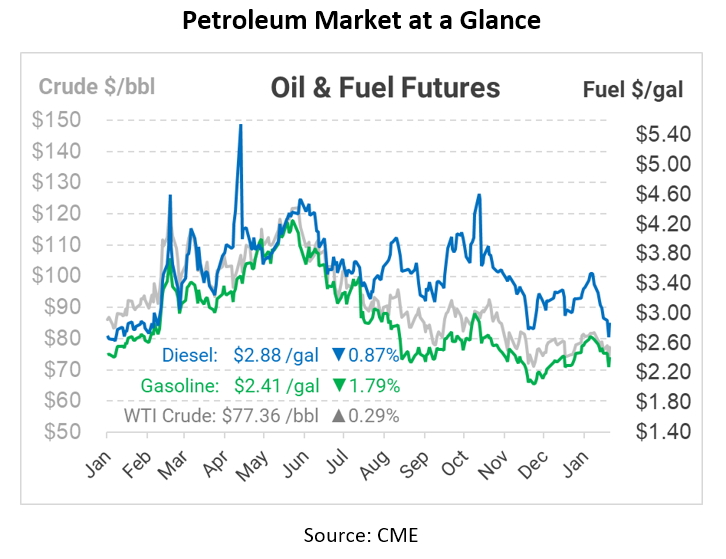
What Is It – OPIS : Oil Price Information Service
As a continuation of our FUELSNews series covering Fuel Price Indexes, today we will cover OPIS. OPIS is a standard fuel price index used across the industry, and you have probably heard it referenced in conversations around your fuel pricing many times. You likely don’t know everything about the company and how they help set fuel price indexes for companies to make wiser purchasing decisions, so let’s cover the basics.
What is OPIS?
OPIS stands for Oil Price Information Service. It is a Dow Jones company and a worldwide provider of petroleum pricing information, data, and market intelligence for the fuel industry. OPIS offers a range of products and services, including real-time and historical pricing information for gasoline, diesel, ethanol, and other fuels, as well as news and analysis of market trends and regulatory developments. The company’s clients include fuel marketers, retailers, traders, and other industry participants.
How Does OPIS Set Prices?
OPIS pricing works by collecting and compiling data on wholesale and retail fuel prices from a variety of sources, including oil companies, fuel terminals, and service stations. The company then processes and verifies this data to ensure its accuracy and completeness. This information is then provided to clients through a variety of platforms and formats like real-time data feeds, historical databases, and reports.
The Oil Price Information Service pricing data can be used by clients for numerous purposes, including price discovery, market analysis, price risk management, and benchmarking. The data can also be used to help clients make informed business decisions as well as comply with regulatory requirements related to fuel pricing.
This data can be accessed through various platforms and services like OPISNet, OPIS Mobile, OPIS Spot Ticker, OPIS Bulk Terminals, OPIS Rack, and OPIS Retail. Each of these services is designed to meet the specific needs of different segments of the fuel industry, such as retail marketers, wholesalers, and traders.
What Types of Pricing Does OPIS Offer?
OPIS offers pricing options for NYMEX, spot market, rack market, and retail market fuel purchasing. From the spot to the wholesale rack and terminal markets and ultimately to over 400,000 retail stores across North America and Europe, the Oil Price Information Service prices commodities throughout the supply chain. According to their website, over 100 billion gallons of fuel are purchased according to OPIS benchmarks. OPIS was actually the founder of rack pricing nearly 30 years ago and still, to this day, is a trusted source for this service.
Understanding OPIS Terminology
Gross vs Net –OPIS reports a gross or net pricing index based on whether a supply deal includes a prompt payment discount (net) or not (gross). If you’re familiar with temperature based “gross/net” terminology, the Oil Price Information Service takes that into consideration in their Temperature Correction Assessment.
Contract vs Closing Summary vs Calendar Day – Rack suppliers may change their price throughout the day, so it’s important to know when the snapshot of the market occurred. OPIS’s “Contract Summary” price is a snapshot of the market at 10:00 am ET. The Closing Summary is the market price at 4:59pm ET, and the Calendar Day Summary snapshot occurs at 11:59 pm ET. The Contract price is the most common.
Low, Average, High – OPIS captures a low price, average, and high for each market. The most typical index is the average, though some contracts are based on the low.
Unbranded vs Branded – OPIS differentiates its supply based on who posts the price. Branded supply is typically sold from a major refiner to its franchises retail brands (ie, Exxon selling to an Exxon-branded station). The branded price tends to be slightly higher than unbranded rack supply, though occasionally branded prices are lower than the market average.
How Does OPIS Fit into My Fuel Price?
If your company uses a fuel index, there’s a good chance that it’s tied to one of OPIS’s key indexes. The most popular index among Mansfield’s customers is OPIS Gross Contract Average – the average price of fuel without prompt-pay discounts at 10am.
At the end of the day, there is no “best” index to use. Different indexes can offer different risks, but a good supplier will know the historical trends and aim to get you roughly the same all-in price regardless of the index used. Talk to your fuel supplier to find out if there’s an optimal pricing method for your market based on your consumption levels.
This article is part of Daily Market News & Insights
Tagged:
MARKET CONDITION REPORT - DISCLAIMER
The information contained herein is derived from sources believed to be reliable; however, this information is not guaranteed as to its accuracy or completeness. Furthermore, no responsibility is assumed for use of this material and no express or implied warranties or guarantees are made. This material and any view or comment expressed herein are provided for informational purposes only and should not be construed in any way as an inducement or recommendation to buy or sell products, commodity futures or options contracts.






